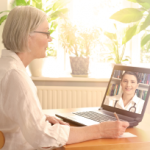Telemedicine—dubbed “telerheumatology” among rheumatology providers—has seen a dramatic uptick in use during the COVID-19 pandemic. Between February and April this year, telehealth visits jumped from 0.1% to 43.5% among Medicare patients seeking primary care.
This new model of healthcare delivery looks like it is here to stay, as the Centers for Medicare & Medicaid Services and other payers evolve more permanent reimbursement rules for telemedicine beyond the pandemic. Learn about the opportunities and challenges of telemedicine at a comprehensive ACR Convergence session on Telerheumatology: How COVID-19 Changed It & What’s in the Future on Friday, Nov. 6, from 3–3:45 p.m. EST.
As described in the ACR’s position statement on telemedicine, updated in September, telemedicine presents unique opportunities to treat immunocompromised patients with rheumatic diseases without exposing them to potential infection risks at in-person clinic visits. It also offers a way to relieve some patient access limitations caused by workforce shortages. However, telemedicine also creates new challenges, such as how to manage rheumatology visits that normally require a hands-on physical exam and how practices can make telerheumatology a sustainable business model.
Chris Phillips, MD, will open the education session with discussion on the uses of telemedicine through the coronavirus pandemic based on his own use of telemedicine from his practice in Paducah, Ky. He will also describe his experiences with regulatory changes occurring due to COVID-19 through his work with the ACR’s COVID-19 Practice & Advocacy Task Force and his role as chair of the ACR’s Committee on Rheumatologic Care Insurance Subcommittee. “Attendees can expect to gain understanding of the current regulatory/insurance environment of telehealth, as well as preparation tools for telehealth post-pandemic,” Dr. Phillips says.
Dr. Phillips will also share what the College knows about the future of these regulatory changes post-pandemic and will review telehealth resources the ACR has created to assist members with coding, private payer policies and cross-state practice regulations.
In the next portion of the session, Christine Peoples, MD, clinical professor of medicine and part of the Telemedicine Services team at the University of Pittsburgh Medical Center (UPMC), will give an overview of the history of how telemedicine began as a new model of healthcare delivery, and discuss outcome-based research in telemedicine. She will also share a roadmap to implementation for best practices and operations to help other rheumatologists build sustainable, profitable telerheumatology programs. “The roadmap I will be outlining is largely based upon our program at UPMC, along with some information about other telemedicine programs at other institutions,” Dr. Peoples notes.
The last 15 minutes of the session will be designated for attendees to ask questions and share their experiences with telemedicine. “We are all still figuring out the best way to do this, and it will be useful to hear many different perspectives from our colleagues about what has worked and what has not,” Dr. Phillips says.
Carina Stanton is a freelance science journalist based in Denver.



